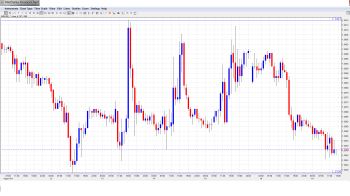EUR/USD is trading quietly on Tuesday, as the pair trades in the mid-1.33 range in the European session. On the release front, there was more bad news out of the Eurozone, as Current Balance dropped sharply in July. In the US, we’ll get a look at key inflation indicators, with the release of Core CPI and CPI. As well, Building Permits and Housing Starts are also on today’s schedule.
Here is a quick update on what’s moving the pair.
- EUR/USD has shown little movement in the Asian and European sessions.
- Current range: 1.3333 to 1.3415.
Further levels in both directions:
- Below: 1.3333, 1.3295 and 1.32.
- Above: 1.3415, 1.3450 and 1.35
- The latest 9 month-low of 1.3333 (or 0.75 on USD/EUR) is strong support.
- 1.3450 is the strong resistance line.
EUR/USD Fundamentals
- 8:00 Eurozone Current Account. Estimate 19.3B, actual 13.1B.
- 12:30 US Building Permits. Estimate 1.00M.
- 12:30 US CPI. Estimate 0.1%.
- 12:30 US Core CPI. Estimate 0.2%.
- 12:30 US Housing Starts. Estimate 0.97M.
*All times are GMT.
For more events and lines, see the Euro to dollar forecast.
EUR/USD Sentiment
- Markets eye US inflation numbers: With persistently low inflation levels in the US, markets expectations have been low for key inflation indicators. CPI is expected to post a 0.1%, while the estimate for Core CPI stands at 0.2%. On Friday, PPI, the primary gauge of inflation in the manufacturing sector, slipped to 0.1%, down from 0.4% in July. This matched the estimate. Weak inflation is one reason why the Federal Reserve is in no rush to raise interest rates, as low inflation points to slack in the economy.
- Spotlight on Fed: This week’s FOMC meeting minutes will supply new information about the internal thinking at the central bank. They usually tend to move markets despite the publication at a time of low volatility. Yet this is only the first course: Janet Yellen will give a speech in Jackson Hole on Friday at a gathering of central bankers, her first as head of the Fed. The speech will be closely watched. Will she take a step forward and acknowledge the recovery or remain extra cautious?
- No growth in the Eurozone: The lack of growth in the Eurozone continue to raise concerns. The euro-zone output remained unchanged in Q2. French preliminary GDP remained flat at 0.0%, unchanged from a month earlier. German preliminary GDP slipped to -0.2%, the first contraction in the German economy since Q4 of 2012. Other numbers, such as German business confidence, remain pressured.
- German, French inflation remains sluggish: The ECB has tried to stave off deflation concerns with interest rate cuts, but inflation levels have not risen. Eurozone Final CPI dipped to 0.4%, down from 0.5% a month earlier. Draghi did not seem worried about this, but did go to explain why EUR/USD should slide.
- US employment data remains solid: The Fed favorite JOLTS figure continued advancing, even if this time it didn’t stand out. Weekly jobless claims bounced back up above 300K, but the 4-week moving average remains low and this could certainly encourage the Fed regarding an interest rate hike.
- Geopolitics could rattle markets: Hotspots in Ukraine and the Middle East remain tense and could have dramatic effects on the markets. In eastern Ukraine, more fighting has been reported between Ukrainian forces and pro-Russian separatists, and large numbers of Russian forces remain close to the border. In Iraq, Kurdish forces, aided by US air strikes, are battling with Islamic State militants. As political turmoil continues in Iraq, the national government is becoming increasingly irrelevant. In Gaza, a ceasefire between Israel and Hamas is set to expire late Tuesday, with negotiations over a long-term agreement continuing in Egypt.

